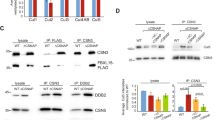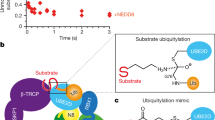Abstract
SCF-type E3 ubiquitin ligases are multi-protein complexes required for polyubiquitination and subsequent degradation of target proteins by the 26S proteasome1. Cullins, together with the RING-finger protein Rbx1, form the catalytic core of the ligase, and recruit the substrate-recognition module1,2,3,4. Cycles of covalent modification of cullins by the ubiquitin-like molecule Nedd8 (neddylation)5 and removal of Nedd8 by the COP9 signalosome (deneddylation) positively regulate E3 ligase activity6,7. Here we report the identification and analysis of a widely conserved protein that is required for cullin neddylation in the nematode Caenorhabditis elegans and the yeast Saccharomyces cerevisiae. C. elegans DCN-1 and S. cerevisiae Dcn1p (defective in cullin neddylation) are characterized by a novel UBA-like ubiquitin-binding domain and a DUF298 domain of unknown function. Consistent with their requirements for neddylation, DCN-1 and Dcn1p directly bind Nedd8 and physically associate with cullins in both species. Moreover, overexpression of Dcn1p in yeast results in the accumulation of Nedd8-modified cullin Cdc53p. Both in vivo and in vitro experiments indicate that Dcn1p does not inhibit deneddylation of Cdc53p by the COP9 signalosome, but greatly increases the kinetics of the neddylation reaction.
This is a preview of subscription content, access via your institution
Access options
Subscribe to this journal
Receive 51 print issues and online access
$199.00 per year
only $3.90 per issue
Buy this article
- Purchase on Springer Link
- Instant access to full article PDF
Prices may be subject to local taxes which are calculated during checkout




Similar content being viewed by others
References
Deshaies, R. J. SCF and Cullin/Ring H2-based ubiquitin ligases. Annu. Rev. Cell Dev. Biol. 15, 435–467 (1999)
Kile, B. T. et al. The SOCS box: a tale of destruction and degradation. Trends Biochem. Sci. 27, 235–241 (2002)
Pintard, L. et al. The BTB protein MEL-26 is a substrate-specific adaptor of the CUL-3 ubiquitin-ligase. Nature 425, 311–316 (2003)
Furukawa, M., Ohta, T. & Xiong, Y. Activation of UBC5 ubiquitin-conjugating enzyme by the RING finger of ROC1 and assembly of active ubiquitin ligases by all cullins. J. Biol. Chem. 277, 15758–15765 (2002)
Pan, Z. Q., Kentsis, A., Dias, D. C., Yamoah, K. & Wu, K. Nedd8 on cullin: building an expressway to protein destruction. Oncogene 23, 1985–1997 (2004)
Lyapina, S. et al. Promotion of NEDD-CUL1 conjugate cleavage by COP9 signalosome. Science 292, 1382–1385 (2001)
Pintard, L. et al. Neddylation and deneddylation of CUL-3 is required to target MEI-1/katanin for degradation at the meiosis-to-mitosis transition in C. elegans. Curr. Biol. 13, 911–921 (2003)
Kurz, T. et al. Cytoskeletal regulation by the Nedd8 ubiquitin-like protein modification pathway. Science 295, 1294–1298 (2002)
McNally, F. J. & Vale, R. D. Identification of katanin, an ATPase that severs and disassembles stable microtubules. Cell 75, 419–429 (1993)
Srayko, M., Buster, D. W., Bazirgan, O. A., McNally, F. J. & Mains, P. E. MEI-1/MEI-2 katanin-like microtubule severing activity is required for Caenorhabditis elegans meiosis. Genes Dev. 14, 1072–1084 (2000)
Dow, M. R. & Mains, P. E. Genetic and molecular characterization of the Caenorhabditis elegans gene, mel-26, a postmeiotic negative regulator of mei-1, a meiotic-specific spindle component. Genetics 150, 119–128 (1998)
Gonczy, P. et al. Functional genomic analysis of cell division in C. elegans using RNAi of genes on chromosome III. Nature 408, 331–336 (2000)
Fraser, A. G. et al. Functional genomic analysis of C. elegans chromosome I by systematic RNA interference. Nature 408, 325–330 (2000)
Bucher, P., Karplus, K., Moeri, N. & Hofmann, K. A flexible motif search technique based on generalized profiles. Comput. Chem. 20, 3–23 (1996)
Meyer, H. H., Wang, Y. & Warren, G. Direct binding of ubiquitin conjugates by the mammalian p97 adaptor complexes, p47 and Ufd1-Npl4. EMBO J. 21, 5645–5652 (2002)
Liakopoulos, D., Doenges, G., Matuschewski, K. & Jentsch, S. A novel protein modification pathway related to the ubiquitin system. EMBO J. 17, 2208–2214 (1998)
Lammer, D. et al. Modification of yeast Cdc53p by the ubiquitin-related protein rub1p affects function of the SCFCdc4 complex. Genes Dev. 12, 914–926 (1998)
Uetz, P. et al. A comprehensive analysis of protein-protein interactions in Saccharomyces cerevisiae. Nature 403, 623–627 (2000)
Giot, L. et al. A protein interaction map of Drosophila melanogaster. Science 302, 1727–1736 (2003)
Cope, G. A. et al. Role of predicted metalloprotease motif of Jab1/Csn5 in cleavage of Nedd8 from Cul1. Science 298, 608–611 (2002)
Morimoto, M., Nishida, T., Nagayama, Y. & Yasuda, H. Nedd8-modification of Cul1 is promoted by Roc1 as a Nedd8–E3 ligase and regulates its stability. Biochem. Biophys. Res. Commun. 301, 392–398 (2003)
Zheng, J. et al. CAND1 binds to unneddylated CUL1 and regulates the formation of SCF ubiquitin E3 ligase complex. Mol. Cell 10, 1519–1526 (2002)
Liu, J., Furukawa, M., Matsumoto, T. & Xiong, Y. NEDD8 modification of CUL1 dissociates p120(CAND1), an inhibitor of CUL1–SKP1 binding and SCF ligases. Mol. Cell 10, 1511–1518 (2002)
Kawakami, T. et al. NEDD8 recruits E2-ubiquitin to SCF E3 ligase. EMBO J. 20, 4003–4012 (2001)
Dharmasiri, S., Dharmasiri, N., Hellmann, H. & Estelle, M. The RUB/Nedd8 conjugation pathway is required for early development in Arabidopsis. EMBO J. 22, 1762–1770 (2003)
Guthrie, C. & Fink, G. R. in Guide to Yeast Genetics and Molecular Biology (eds Abelson, J. N. & Simon, M. I.) (Academic, San Diego, California, 1991)
Hofmann, K. Sensitive protein comparisons with profiles and hidden Markov models. Brief. Bioinform. 1, 167–178 (2000)
Jaquenoud, M., Gulli, M. P., Peter, K. & Peter, M. The Cdc42p effector Gic2p is targeted for ubiquitin-dependent degradation by the SCFGrr1 complex. EMBO J. 17, 5360–5373 (1998)
Verma, R., Chi, Y. & Deshaies, R. J. Cell-free ubiquitination of cell cycle regulators in budding yeast extracts. Methods Enzymol. 283, 366–376 (1997)
Acknowledgements
We thank M. Srayko for providing DCN-1 cDNA; M. Tyers and X. Tang for purified Cdc53p–Rbx1p complex; S. Rybina for help with antibody purification; and J. C. Labbé and L. Pintard for critical reading of the manuscript. T.K. was supported by an American Heart Association Pre-doctoral Fellowship and an EMBO Long-Term Fellowship, S.M.O. by the Damon Runyon Cancer Research Foundation, B.B. by the NIH, and M.P. by the ETHZ and the Swiss National Science Foundation.
Author information
Authors and Affiliations
Corresponding authors
Ethics declarations
Competing interests
Reprints and permissions information is available at npg.nature.com/reprintsandpermissions. The authors declare no competing financial interests.
Supplementary information
Supplementary Video S1
This time-lapse movie shows the first mitotic division of a Caernorhabditis elegans embryo expressing a GFP::MEI-1 fusion protein. It is evident from this movie that under wildtype conditions MEI-1 protein does not localize to the mitotic spindle. (MOV 9187 kb)
Supplementary Video 2
This time-lapse movie shows the first mitotic division of a C. elegans embryo expressing a GFP::MEI-1 fusion protein, in which dcn-1 has been inactivated by RNAi. It is evident from this movie that loss of DCN-1 results in the stabilization of MEI-1 protein and its ectopic association with the mitotic spindle. (MOV 2982 kb)
Supplementary Video Legends
Legends to accompany the above Supplementary Videos (DOC 20 kb)
Supplementary Figures
Supplementary Figure S1, multiple alignment of DUF298 domains; Supplementary Figure S2, multiple alignment of UBA-like domains; Supplementary Figure S3, drawing of the two C. elegans DCN-1 spliceforms; Supplementary Figure S4, subcellular localization of CeDCN-1; Supplementary Figure S5, neddylation state of cullin Rtt101p. (DOC 878 kb)
Supplementary Table S1
Table of yeast strains used in this study. (DOC 32 kb)
Supplementary Methods
This file contains additional Methods that could not be displayed in the print version. (DOC 23 kb)
Rights and permissions
About this article
Cite this article
Kurz, T., Özlü, N., Rudolf, F. et al. The conserved protein DCN-1/Dcn1p is required for cullin neddylation in C. elegans and S. cerevisiae. Nature 435, 1257–1261 (2005). https://doi.org/10.1038/nature03662
Received:
Accepted:
Issue Date:
DOI: https://doi.org/10.1038/nature03662
This article is cited by
-
Targeting neddylation E2s: a novel therapeutic strategy in cancer
Journal of Hematology & Oncology (2021)
-
Selective inhibition of cullin 3 neddylation through covalent targeting DCN1 protects mice from acetaminophen-induced liver toxicity
Nature Communications (2021)
-
A potent small-molecule inhibitor of the DCN1-UBC12 interaction that selectively blocks cullin 3 neddylation
Nature Communications (2017)
-
SOCS2 Binds to and Regulates EphA2 through Multiple Mechanisms
Scientific Reports (2017)
Comments
By submitting a comment you agree to abide by our Terms and Community Guidelines. If you find something abusive or that does not comply with our terms or guidelines please flag it as inappropriate.



